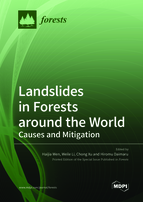Landslides in Forests around the World: Causes and Mitigation
A special issue of Forests (ISSN 1999-4907). This special issue belongs to the section "Natural Hazards and Risk Management".
Deadline for manuscript submissions: closed (31 December 2022) | Viewed by 32298
Special Issue Editors
Interests: natural disasters; engineering risk; machine learning; remote sensing
Special Issues, Collections and Topics in MDPI journals
Interests: landslide detection; landslide monitoring; landslide prediction; landslide risk assessment; remote sensing; InSAR
Special Issues, Collections and Topics in MDPI journals
Interests: earthquake-triggered landslides; rainfall-triggered landslides; active faults; hazard and risk mapping; landslide inventory
Special Issues, Collections and Topics in MDPI journals
Interests: landslide risk evaluation and mapping; geomorphology; GIS
Special Issues, Collections and Topics in MDPI journals
Special Issue Information
Dear Colleagues,
Landslides are one of the most pervasive natural hazards and usually result in enormous human casualties and property losses. With population growth, the expansion of infrastructure, and increased agricultural activity in forest areas, the significance of landslides is set to increase in the future. The climate-change-related impacts, including an increased frequency of extreme rainfall events and heightened risk of forest dieback and wildfires, are likely to result in compound effects on the landslide incidence. Forests and landslides have strong inter-influences. However, there is a lack of precise understanding of the role of forests in relation to landslides. Landslide disaster prevention and mitigation are urgent needs and challenging tasks in the practice of landslides in forests. In the last decade, great progresses have been made, particularly on the new methods based on optical remote sensing, InSAR, LiDAR, and so on in association with artificial intelligence methods for landslide detection, monitoring, early warning, and risk assessment. The rapid advancement in this active field has shed light on effective and on-time responses to potential landslide preventions and mitigations in the forest regions.
Aim and Scope: This Special Issue aims to collect the latest developments and applications of both basic and applied research on forest landslides, with particular attention to the causes of and solutions to landslides. Research can focus, but is not limited to, climate change, extreme rainfall, earthquakes, and human-activity-induced landslides in forests. Research also can pay attention to the occurrence mechanism, susceptibility, hazard, and risk of landslides. The application research of artificial intelligence methods such as machine learning/deep learning, and remote sensing technologies such as optical remote sensing, LiDAR, and InSAR are particularly welcome.
History: The main contents of landslide research are the occurrence mechanism, on-site detection and monitoring, susceptibility and hazard mapping, early warning, and risk assessment. Researchers have developed a variety of model tests, statistical and numerical simulation methods, and monitoring technologies.
Cutting-edge Research: In recent decades, earth observations in association with deep learning in artificial intelligence (AI) have drawn more and more attention, and great progress has been made, particularly on the new methods based on optical remote sensing, InSAR, LiDAR, and so on in association with convolutional neural networks (CNNs) for landslide detection, hazard and risk assessment, monitoring, and early warning.
What kind of papers we are soliciting: Innovative methods and original applications (including but not limited to landslide mechanisms, inventorying, prediction, recognition, early warning systems, susceptibility mapping, risk management, spatial modeling, and mitigations) would be appropriate.
Dr. Haijia Wen
Dr. Weile Li
Prof. Dr. Chong Xu
Dr. Hiromu Daimaru
Guest Editors
Manuscript Submission Information
Manuscripts should be submitted online at www.mdpi.com by registering and logging in to this website. Once you are registered, click here to go to the submission form. Manuscripts can be submitted until the deadline. All submissions that pass pre-check are peer-reviewed. Accepted papers will be published continuously in the journal (as soon as accepted) and will be listed together on the special issue website. Research articles, review articles as well as short communications are invited. For planned papers, a title and short abstract (about 100 words) can be sent to the Editorial Office for announcement on this website.
Submitted manuscripts should not have been published previously, nor be under consideration for publication elsewhere (except conference proceedings papers). All manuscripts are thoroughly refereed through a single-blind peer-review process. A guide for authors and other relevant information for submission of manuscripts is available on the Instructions for Authors page. Forests is an international peer-reviewed open access monthly journal published by MDPI.
Please visit the Instructions for Authors page before submitting a manuscript. The Article Processing Charge (APC) for publication in this open access journal is 2600 CHF (Swiss Francs). Submitted papers should be well formatted and use good English. Authors may use MDPI's English editing service prior to publication or during author revisions.
Keywords
- landslides in forests
- landslide inventory
- remote sensing
- spatial-temporal prediction
- machine learning
- deep learning
- physics-based and data-driven hybrid modeling
- susceptibility and hazard mapping
- risk assessment and management
- monitoring and early warning







